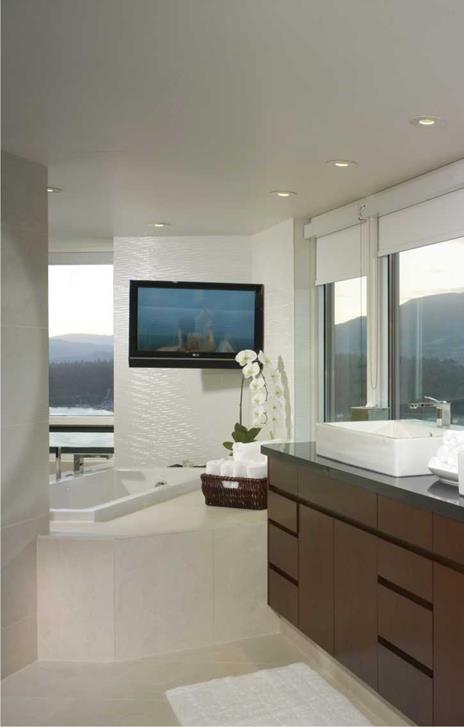Communication devices are now coming to the bathroom, and the essential wiring for them should be considered in your design, especially in the luxury category. Linking the bathroom to the outside world and other parts of the house requires special wiring and planning. With new structured wiring bundles, many of the wires for communication are bundled together to make installation easier.
Internal home communication networks such as intercoms are becoming common, and bathrooms are logical components of these networks. Intercoms can be especially important if small children or older adults need assistance, but they must be easy to use and located where all users can easily access the controls. Wiring needs to be incorporated early in the project so that the speakers and controls for the system can be placed appropriately and wiring can be hidden behind walls. A telephone in the bathroom was once a luxury, but it can now be an easy addition. All it takes is extending another phone line. Although the phone is often found near the toilet, it can be located wherever the client finds it convenient to use, like near a sitting area. Help systems that use telephone lines for emergency calls may also be desired. Place the system where it can be easily accessed if someone needs help. A charging station for cell phones may also need to be located in the bathroom area.
As families include more activities in the bathroom, the television becomes a regular feature (see Figure 7.3). Linking the bathroom to the home cable or satellite system will allow family members to keep up with the news while they dress for work in the morning which might be a television screen as part of the mirror, view a program in the exercise area, and watch television as they relax in a spa or jetted tub. Some whirlpool and jetted tubs now come with the television built in. Connections for a DVD player and sound system are also part of the entertainment package. If the client does not want electronic equipment in the bathroom space, an alternative is to install speakers in the ceiling or in the wall which connect to equipment elsewhere.
Although Internet connections are not common in bathrooms at this time, there is no doubt they will be coming, especially as medical monitoring and security systems gain in popularity. Wiring for the Internet now, in anticipation of new uses, would be wise. Wireless systems could also be considered.
HEATING
Stepping out of a shower or tub with wet skin can be very chilling if the bathroom air is not at a comfortable temperature. There are many ways in which to add heat to the bathroom. The first step, however, is to take measures to reduce heat loss by sealing leaks, improving insulation in exterior walls, and upgrading the windows. Chapter 2, "Infrastructure Considerations," and chapter 3, "Environmental and Sustainability Considerations," provide more information on energy-efficiency considerations.
|
|||
|
|||
|
|||
|
|||
|
|||
|
|||
|
|||
|
|||
|
|||
|
|||
|
|||
|
|||
|
|
||
|
|
||
|
|||
|
|||
|
|||

![]()
FIGURE 7.2 GFCI receptacles should be planned at each electrical point of use (Bathroom Planning Guideline 24). The correct electrical information on a mechanical plan will ensure that all electrical connections are included.
NKBA
|




